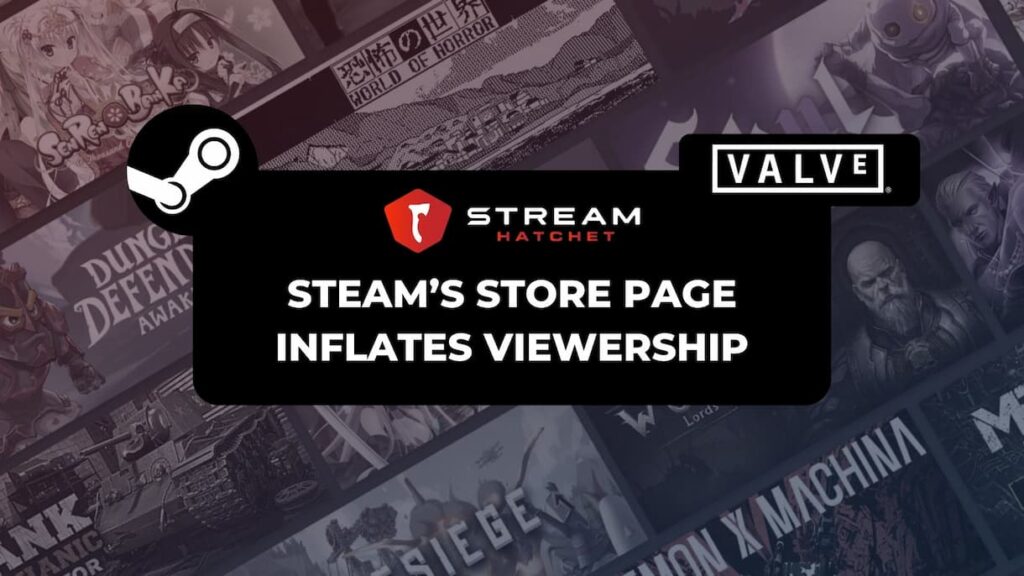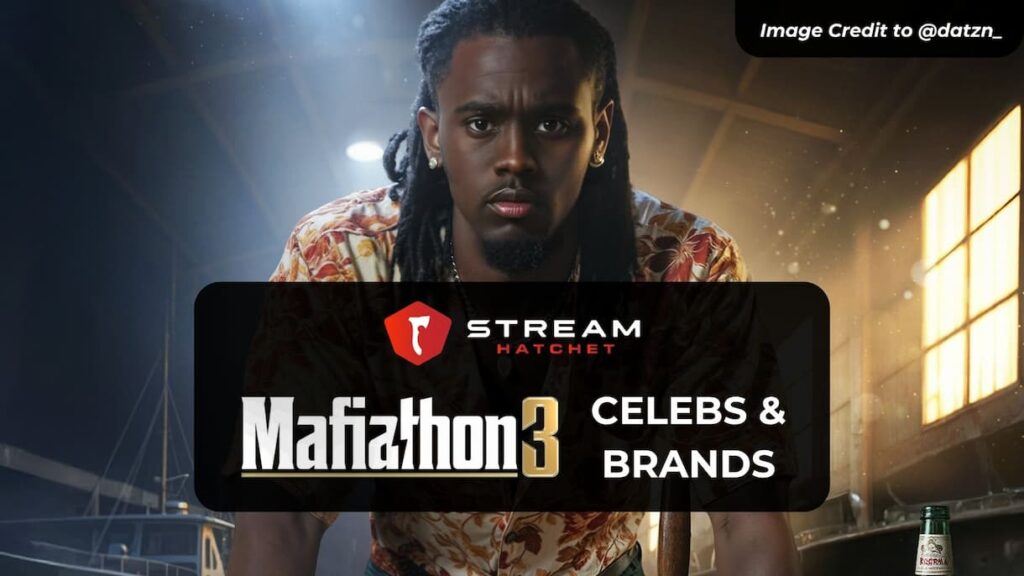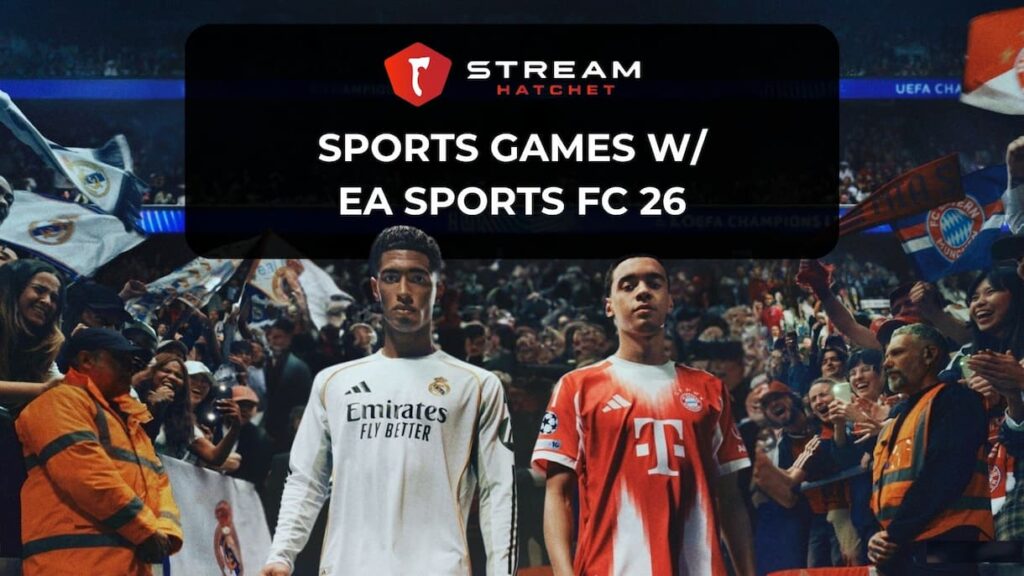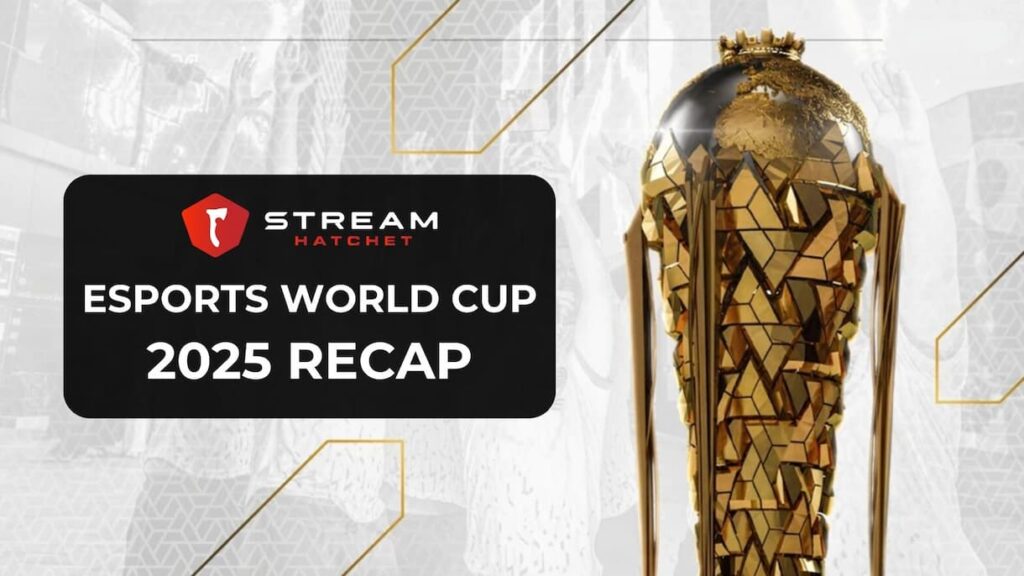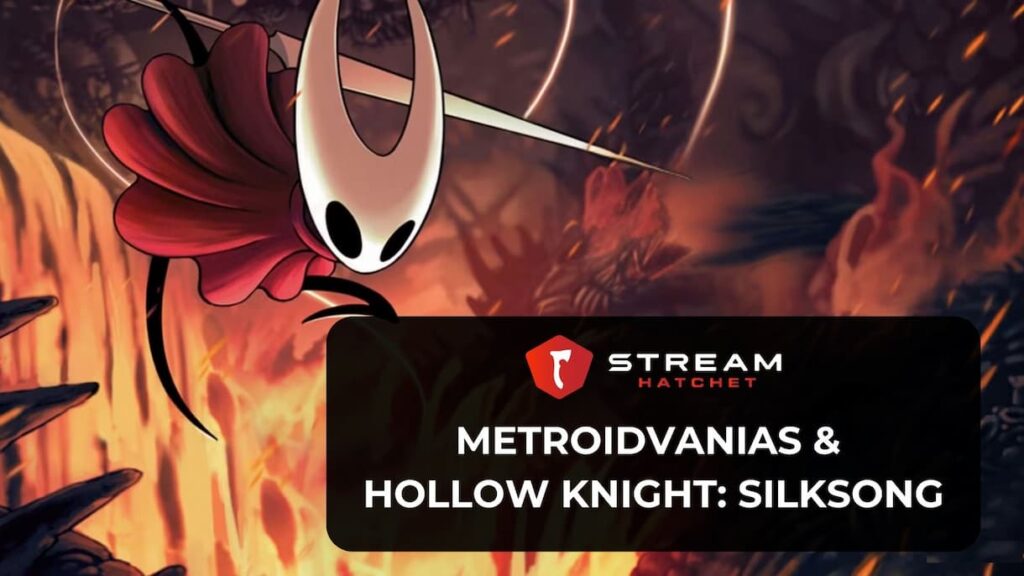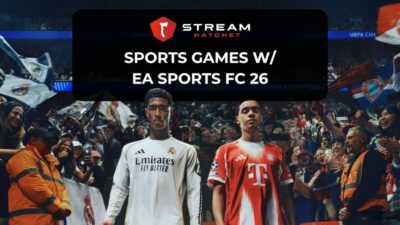PC users buy the majority of their games through Steam (with the exception of some alternatives like Epic Games, GOG, or publisher-specific launchers like Blizzard’s Battle.net). As a funnel point with high traffic, this makes the Steam Store page a highly precious conversion point in the PC game publisher’s marketing campaign. Studios will try to optimize this space to game the Steam algorithm and get attention.
To capitalize on this, studios big and small will run live streams on the top of the Steam Store page, providing a sense of community and a behind-the-scenes look at development. While it may seem like a given that these Steam Store page streams increase engagement, they can be deeply misleading when it comes to assessing a game’s reach. To show you what we mean, we’re taking a deeper look at the effect of Steam viewership on live-streaming performance: How do these live streams affect the perception of a game’s success among live-streaming audiences, and are they really the best strategy for marketing your game?
Basics of Live Streaming on Steam and the Steam Store Page
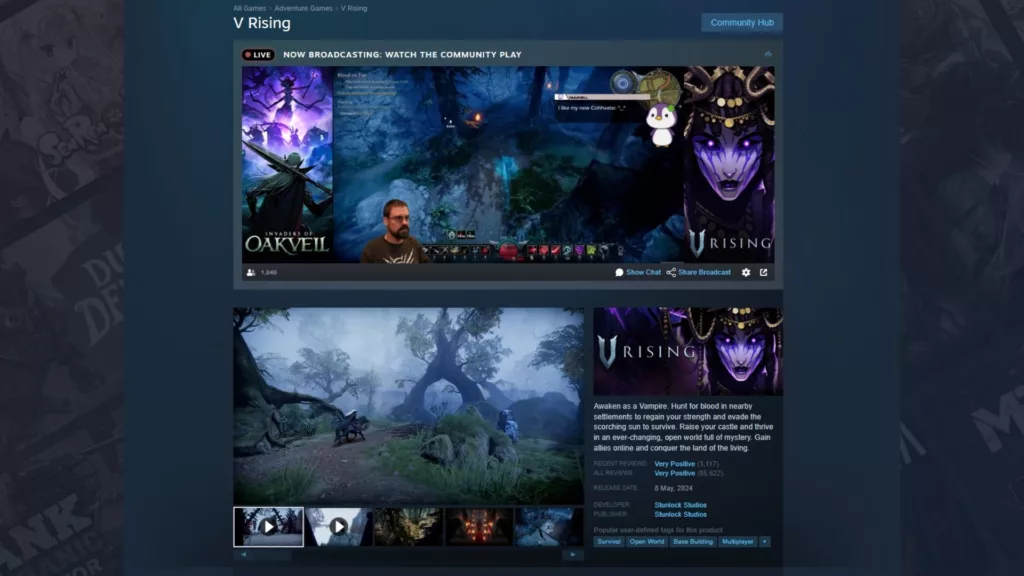
Steam provides a detailed user guide for live streaming on its platform which all publishers and streamers should have a look at. But from a consumer perspective, the gist is this: Publishers will host live streams at the tops of their Steam Store pages featuring either raw gameplay, development streams, or (more rarely) streamer collaborations. Steam currently puts these streams at the very top of the page, valuing them above any other Store page content including trailers, game descriptions, or reviews. The stream also follows the user down the page as they scroll (via a pop-up in the corner), meaning that as long as you’re on the Steam Store page, the broadcast is playing.
The thing is, these Steam live streams don’t actually have to be live. More often than not, Steam Store page streams are just looped footage of an original stream played on repeat. Because the chat function does remain live, however, the stream will say that it’s live (a little bit disingenuous). If looped footage following you down the page annoys you, you can turn off broadcasts in your Steam settings. It’s worth noting that there are genuine streamers on Steam other than those channels set up by publishers, but we’ll see in a moment how their impact on overall Steam viewership for a game is relatively negligible.
Steam Can Seriously Inflate Game Launch Viewership
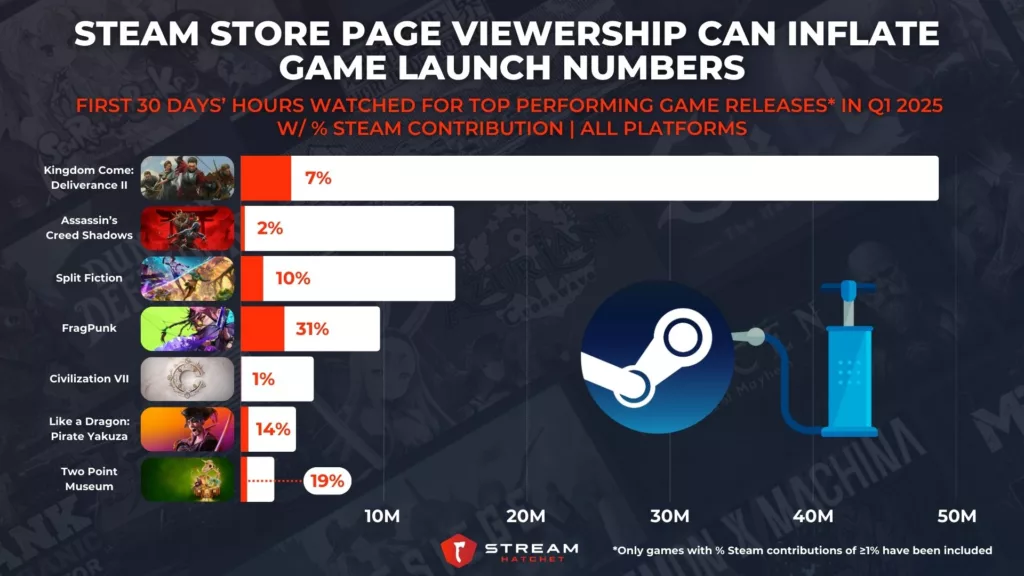
We’ve previously looked at how a lot of Steam’s live-streaming success can be attributed to new game launches driving traffic to broadcasts on Steam Store pages. Diving deeper, we examined the top 20 game launches from Q1 2025 to see how many derived significant viewership from Steam. As it turns out, 7 of the 20 games owe at least 1% of their first 30 days’ viewership to Steam while the other 13 games saw only a few thousand hours watched on the platform across the same period (including Monster Hunter Wilds, Schedule I, and R.E.P.O.). As a fun fact, it’s also worth noting that two of the biggest game launches from Q2 2025 also owe millions of hours watched to Steam, those being The Elder Scrolls IV: Oblivion Remastered and Clair Obscur: Expedition 33.
Among those 7 games with significant Steam viewerships, FragPunk leads the way with a massive 3M hours watched in its first 30 days, accounting for 31% of its total viewership over that period. This stream seemed to be a rebroadcast of the Shroud vs. TenZ Twitch Rivals match, a sponsored event promoting the game’s launch. Even across the other games though, there was still significant contribution from Steam including Two Point Museum (19%), Like a Dragon: Pirate Yakuza in Hawaii (14%), and Split Fiction (10%). Though Kingdom Come: Deliverance 2’s Steam viewership only accounted for 7% of its total viewership, that’s still 3.5M hours watched! With Steam clearly bringing in big numbers for game launches, it’s worth questioning where exactly this viewership comes from.
Steam Store Page Streams are The Main Contributor to Any Steam Viewership
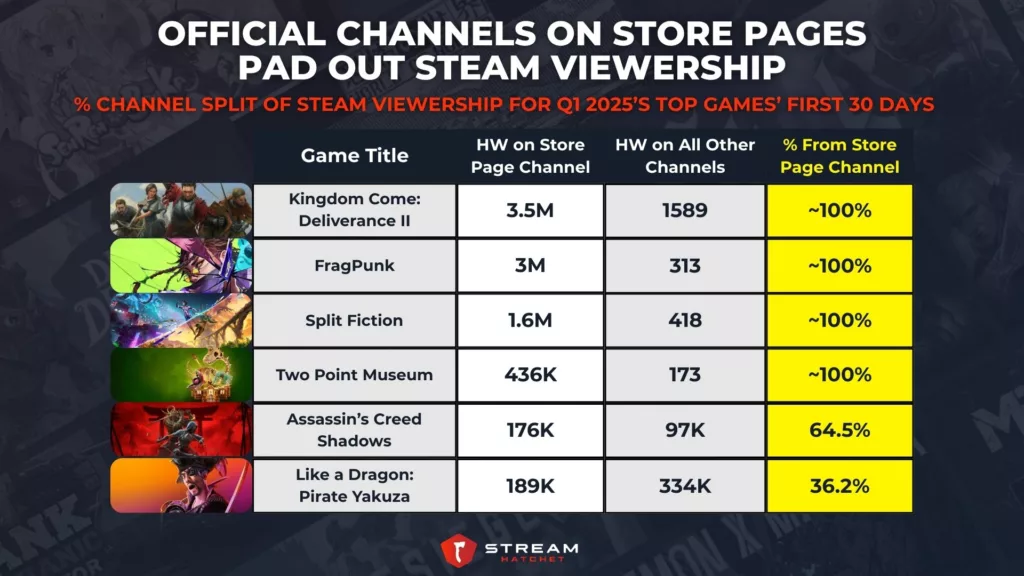
Drilling down into those games, we see a clear trend: All of these games derive the vast majority of their Steam viewership from just a single channel, the same channel that streamed on their Steam Store page. Four of the games (Kingdom Come: Deliverance 2, FragPunk, Split Fiction, and Two Point Museum) owe basically 100% of their Steam viewership to these channels, typically either run by the publisher themselves or, in the case of Two Point Museum, featuring a dev stream. Assassin’s Creed Shadows is the outlier here at 64.5%, instead generating just over ⅓ of its viewership from a real sponsored streamer (itsjavachip) who was rebroadcasting on Steam. Finally, we have Like a Dragon: Pirate Yakuza which is unclear: In addition to the most popular channel at 36.2%, there were two other channels that seem official (PCBIZ1_SOJ and PCBIZ3_SOJ) pulling in the rest of the viewership – but we couldn’t determine what their content was. They may be streams in other languages of the same content.
You might ask why it matters if Steam viewership is coming almost exclusively from the Store page rather than “actual” Steam streams. Keep in mind that as long as the Steam Store page is open, the live stream is playing: That means most of this viewership is likely from passive viewers trying to read reviews or watching trailers rather than actual engaged viewers. If so, then brands should be aware that this viewership isn’t likely to be from active viewers. Game publishers should also be careful: If these viewers are already on the Store page, the live stream isn’t actually generating awareness, which diminishes the power of these figures. Of course, we can’t definitively say that some proportion of these viewers aren’t actively watching these streams… but we’ll see accounts below that corroborate this theory.
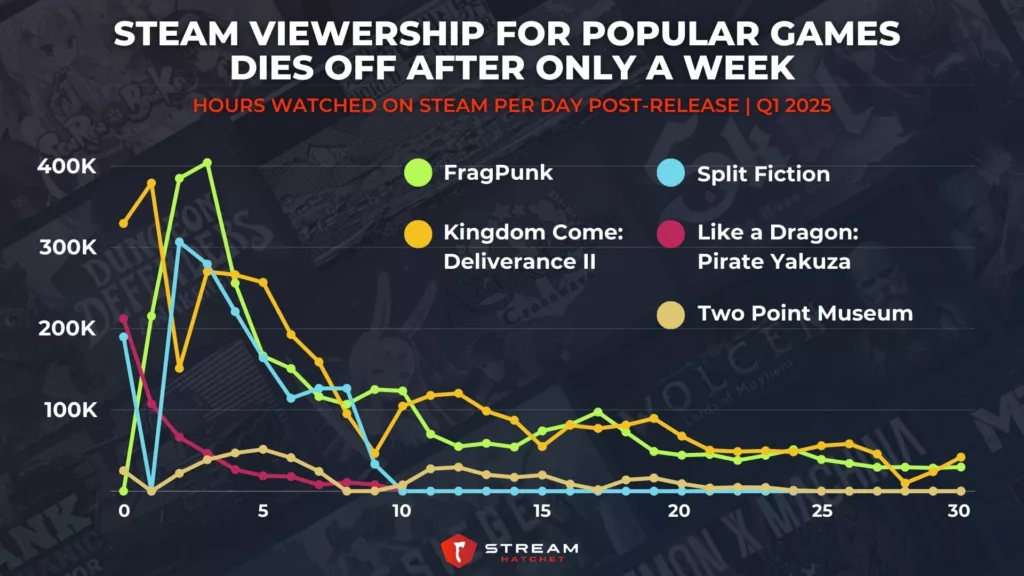
Not only is this viewership from highly passive viewers, but it also dies off quickly. Looking at 5 of these games, viewership drops to below 100K daily hours watched after around 7-10 days, typically when the Steam Store page stream stops running. This makes sense: If most of the viewership is just people visiting the page to decide if they want to buy the game on release, then they’re not actually interested in the stream and won’t come back after having made their decision. This surge in the first week means that if you were judging a game launch’s performance on live streaming by just its first week alone, the inflation effect from Steam viewership becomes even greater. Ultimately, Steam stream viewers then (mostly) won’t stick around and follow live-streaming coverage of the game (though they may move to other live-streaming platforms).
Should Publishers and Developers Be Using Streams on Their Steam Store Pages?
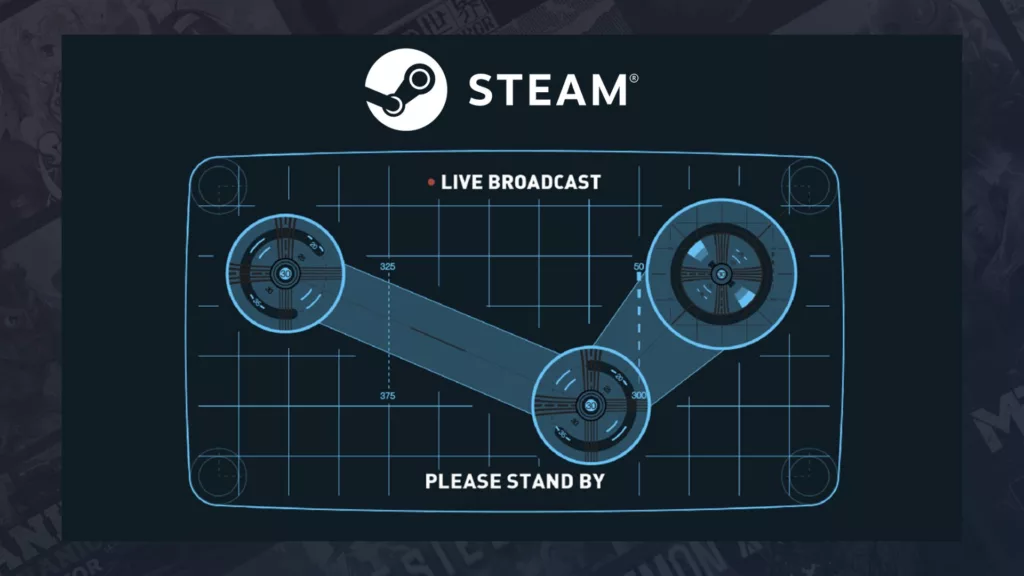
Given our concerns over Steam Store page viewership, this raises a question: Are Store page streams really the best way for game publishers to drive sales? There are a lot of factors to consider here, some relating to generating awareness and others to conversions:
Pros of Steam Store page streams:
- Delivers inflated live-streaming numbers which means higher perceived interest in the title (useful for attracting sponsors, media coverage, and word-of-mouth hype)
- Reaches viewers who might not be on other live-streaming platforms with engaging, live content
- Favors the Steam algorithm which promotes pages that have broadcast viewers (these games can be featured on the game’s related topic hub or the Steam Store front page)
- Demonstrates the game is being actively supported
- Shows a more human side to the game (important for other devs/ committed gamers)
Cons of Steam Store Page streams:
- Creates a misleading impression of live-streaming interest in the game
- May be perceived as a nuisance by players trying to see other content on the Store page (just ask these Redditors)
- Takes precedence over trailers, showing sometimes lackluster gameplay segments (e.g. queuing) instead of well-polished, curated gameplay
- Slows Store page loading times and disrupts buyer experience when it pops in late
- Requires resources to keep the stream running (servers, computing power)
- May accidentally spoil late-game story elements
Of course, the pros and cons of this all depend on what content you’re making and when you run it. For content, well-known streamers with engaging commentary and high-skill and/or interesting gameplay are more likely to capture interest and generate conversions than simple, flat gameplay. Timing-wise, running these streams during events like Steam Next Fest means you’re accessing a more open-minded audience who might be curious about behind-the-scenes footage or willing to watch gameplay for an extended time.
_
What does this mean for judging a game’s launch performance on live streaming? Moving forward, publishers and brands should be careful to double-check launch metrics to see what proportion of them has been boosted by Steam Store page viewership to get a more accurate picture of how much awareness has been raised by their influencer marketing campaigns. For our part here at Stream Hatchet, we’ll try to flag this Steam contribution when covering new game launches to make readers aware of “real” vs. “inflated” metrics.
To keep up to date with tips and tricks for navigating the live-streaming industry, follow Stream Hatchet:

